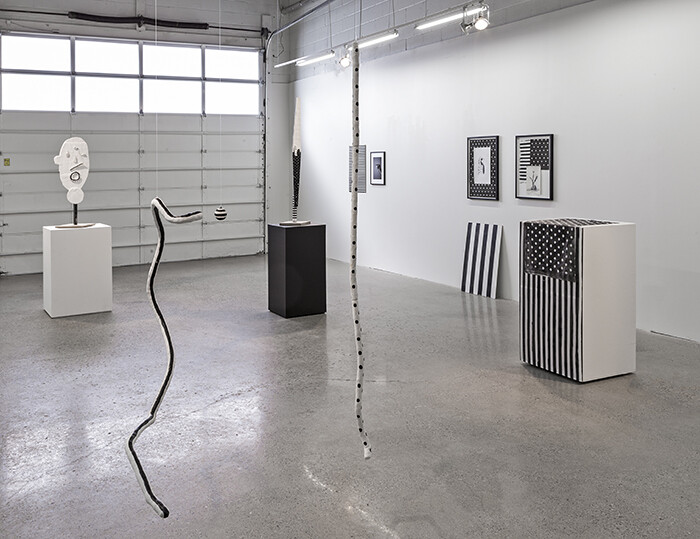Categories
Subjects
Authors
Artists
Venues
Locations
Calendar
Filter
Done
October 19, 2022 – Review
Stephanie Comilang and Simon Speiser’s “Piña, Why is the Sky Blue?”
Jayne Wilkinson

In the world of Piña, the title character of this expansive, speculative work of documentary-fiction, there are few boundaries. Piña stretches across temporalities, geographies, and technologies; it’s a world where futures and pasts align, where spiritual knowledge is transformed and disseminated for generational survival. Each element in Stephanie Comilang and Simon Speiser’s collaborative exhibition—a VR work, a wall-sized video projection, and a series of framed textile works, whose patterns repeat on custom-designed floor cushions—contributes to an experience where body, mind, memory, and technology converge.
The project is structured around an elegant spirit, Piña, named after the Spanish and Tagalog word for pineapple, a fruit first introduced to the Philippines in the seventeenth century by Spanish colonizers who considered it a symbol of luxury. In the distant future, Piña is an omniscient AI-guide that holds and transmits matrilineal knowledge by first receiving information, or “data,” uploaded from knowledge-keepers who preserve spiritual and ecological practices, despite the violence of colonization. In the video, Piña’s presence is felt but unseen, as we meet real-world healers and activists. Among them are Kankwana Canelos and Rupay Gualinga of Ciber Amazonas, a group of Indigenous activists in Puyo, Ecuador, who discuss their work forming feminist alliances …
February 9, 2017 – Review
Michael Snow’s “Powers of Two”
Jacob Korczynski

Throughout an expansive practice that spans more than half a century, Michael Snow has questioned the conditions of perception and pushed against the material properties of multiple mediums. Snow’s work has remained relevant to successive generations of artists because of the generosity it can extend to viewers. In encountering his best work, bodies become a primary site of meaning, a tether between the intellectual and the visceral, the psychological and the physical.
However, there are two sides to every story, and as much as Snow’s work invites it can also exclude, with many of his most iconic pieces fetishizing the bodies of women, creating a space for the viewer determined by a male gaze that is at worst lecherous and at best limiting, reinforcing the boundaries of a gender binary—a power of two. Two Sides to Every Story is also the title of one of Snow’s most visionary works, a 16mm film installation from 1974 that explores the tension between the recto and verso of an image, and while it does not appear in this exhibition, its formal conceit is directly connected to Powers of Two (2003), a large-scale photo installation from which the title of this exhibition is derived.
In the …
March 11, 2014 – Review
Zin Taylor’s “The Story of Stripes and Dots (Chapter 7)”

“This is a dot. A dot is a sound. A dot is a sound in space. This is a dot in space…” This is the voiceover, augmented with psychedelic tonal music, which emanates from a speaker casually draped with hand-painted fabrics reminiscent of an American flag. The sonically infused gallery space is populated with paintings, drawings, photos, and sculptures by Canadian artist Zin Taylor—with each and every one of them featuring black-and-white stripes and dots. Based in Brussels for nearly a decade, Taylor has been gaining an increasing international reputation with exhibitions across Europe and North America. “The Story of Stripes and Dots (Chapter 7)” is now his fourth exhibition at Toronto’s Jessica Bradley Gallery, and is the latest in a series of shows in which he sets out to explore the cornerstones of both abstraction and figuration.
Taylor’s visual vocabulary is intentionally limited to black-and-white stripes and dots; however, it is the syntactical play of these elements in disparate contexts that energize his work. In contrast to the work of the modernist masters that comes to mind when one thinks of philosophies and hypotheses of abstraction—like Kazimir Malevich, Piet Mondrian, or Josef Albers, who each believed that their experiments in …